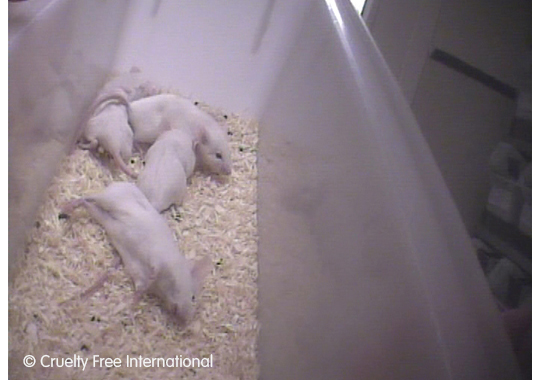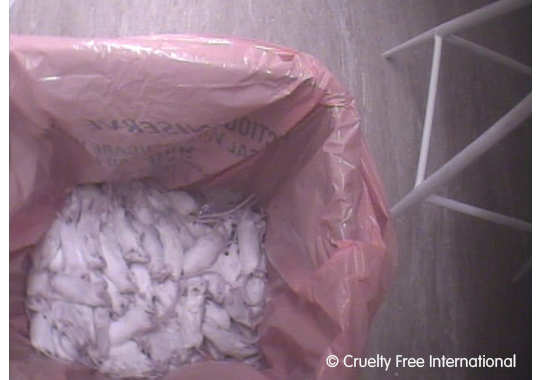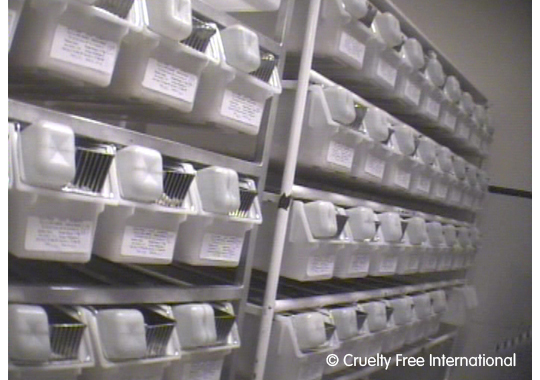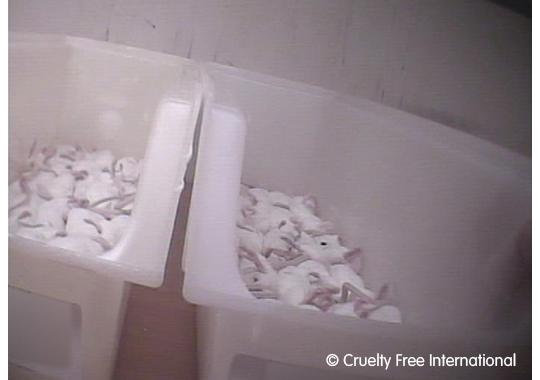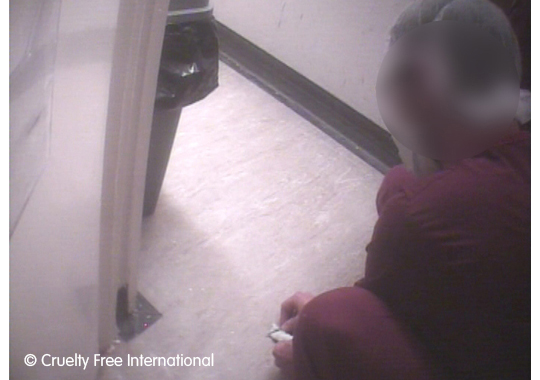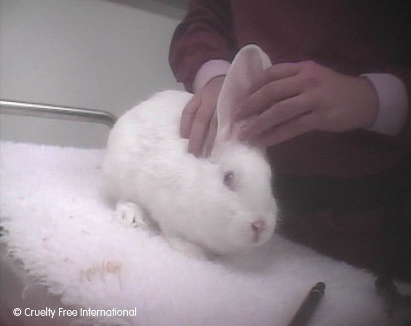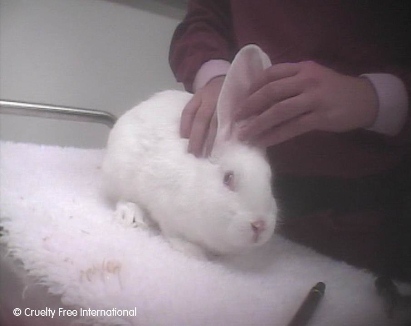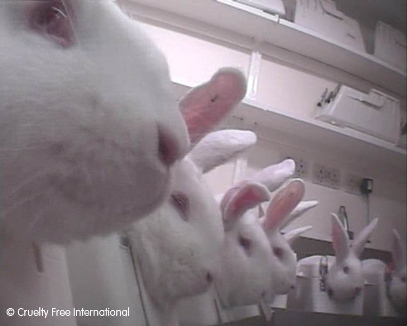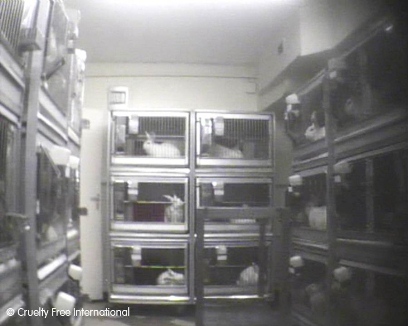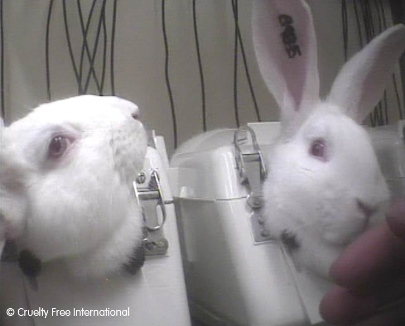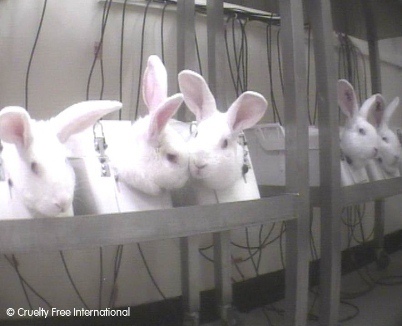Exposed: Appalling suffering at a UK animal testing laboratory
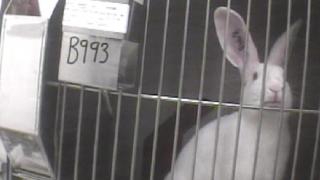
In 2009, our investigator went undercover for 8 months at Wickham Laboratories, a UK contract animal testing laboratory. She secretly filmed the appalling suffering inflicted on thousands of animals in cruel, crude and archaic tests for the routine batch testing of products.
This included the weekly use of hundreds of mice in poisoning tests for Dysport® (a preparation of one of the most toxic substances known, botulinum toxin, commonly known as botox).
Rabbits were also used, in pyrogen (fever) tests where a test substance is injected into an ear vein to detect contaminants and the animals were forcibly restrained by their necks in stocks for hours at a time.
WARNING video contains footage that some viewers may find upsetting
Animal tests for botox
Mice were used in the controversial and cruel “LD50” test for botox. “LD” stands for “lethal dose” and “50” refers to the dose at which 50% of the mice are expected to die when injected with the poison.
The mice were injected into their abdomen with botox and then periodically observed to see how many died. They became increasingly paralysed, eventually gasping for breath and suffocating to death. No pain relief was provided.
The staff were supposed to kill the mice when their suffering became too great. But we discovered this was a sham because far more of the mice died an agonising death than were killed.
Those mice considered unlikely to survive until the next check were taken out into the corridor and crudely killed on the floor by breaking their necks with a ball point pen. New staff, who had never killed mice before, were expected to practise breaking necks on live mice. Sometimes they broke their backs instead of necks causing excruciating agony for the mice.
Using rabbits in tests
The rabbits used in pyrogen tests at Wickham Laboratories could be starved for up to 30 hours prior to the animal experiment. During the test they were forcibly immobilised by their necks in stocks for several hours.
The tests were uncomfortable and distressing for the rabbits. Researchers injected a test substance into a vein in the rabbits’ ears, sometimes resulting in painful damage, and inserted a temperature probe 7.5 cm deep into the rabbits’ rectums which remained in place for hours.
Some of the rabbits struggled against these tests and their confinement. Wickham Laboratories acknowledged that their struggling could result in the rabbits sustaining injuries, particularly to their backs.
Some rabbits were killed at the end of the test. Others were returned to their cages to be re-used again and again in yet more pyrogen tests.
Key findings
Animals were kept in small, virtually barren cages that failed to meet their behavioural and social needs.
Some animals suffered in tests that were no longer required by national and international regulations. This made a mockery out of the often-made claim that companies have to do tests because regulators require them.
The UK government is legally obliged to enforce the use of non-animal alternatives to animal tests where they exist, and to ensure that, if animals are used, then it should be the minimum number and with the minimum amount of suffering. Our investigation found that the UK Government failed to meet this obligation at Wickham Laboratories.
Despite a UK and EU ban on the use of animals for cosmetic testing, animals were allowed to be used in tests for botox. A loophole in the law allows animals to continue to suffer dreadfully in tests for botox because it is licensed for medical use. Yet botox very often ends up being used—quite legally—for cosmetic purposes.
What happened next?
The Home Office investigated the laboratory and produced a damning report agreeing that, by failing to kill the mice and leaving them in extremis, the laboratory had “caused unnecessary and additional suffering”. The report criticised the Named Veterinary Surgeon (NVS) and the person in charge of Animal Welfare. The NVS stepped down. The Home Office admitted there was a conflict of interest since the NVS was a major shareholder in the laboratory.
In 2010, as a direct result of our efforts, the UK Veterinary Medicines Directorate reviewed all their licenses that included batch tests such as pyrogen tests. This resulted in a change to the licenses for 26 drugs, saving the lives of an estimated 38,000 animals over the next five years. The European Medicines Agency also pledged to review their marketing authorisations.
We believe that our Wickham investigation—together with our campaigning and correspondence with the three main companies producing botox products—has encouraged alternative methods to be implemented much faster than they might have been otherwise, saving hundreds of thousands of animals every year from these cruel tests. By 2018, Ipsen had followed companies Allergan and Merz and finally received approval to use their cell-based method.
We took the Home Office to the High Court because they continued to licence Wickham to conduct the mouse tests for products that were ostensibly going to be used for cosmetic purposes, breaching the UK’s policy on cosmetics testing on animals. The judge—in our view—was defeatist in their ruling.
Sadly, in the UK, whilst the number of mice being used for botulinum toxin batch testing is decreasing, huge numbers are still being used. We believe Wickham are continuing to offer this test to companies that have not yet implemented the non-animal method.
Happily, in the UK, the number of rabbits being used in pyrogen tests has been decreasing since the Wickham investigation and was zero in 2019 and 2020. The European Pharmacopeia announced plans to delete the pyrogen test from EU requirements by 2026.
We are continuing to fight to end pyrogen and botox tests - both feature on our EU RAT list.



